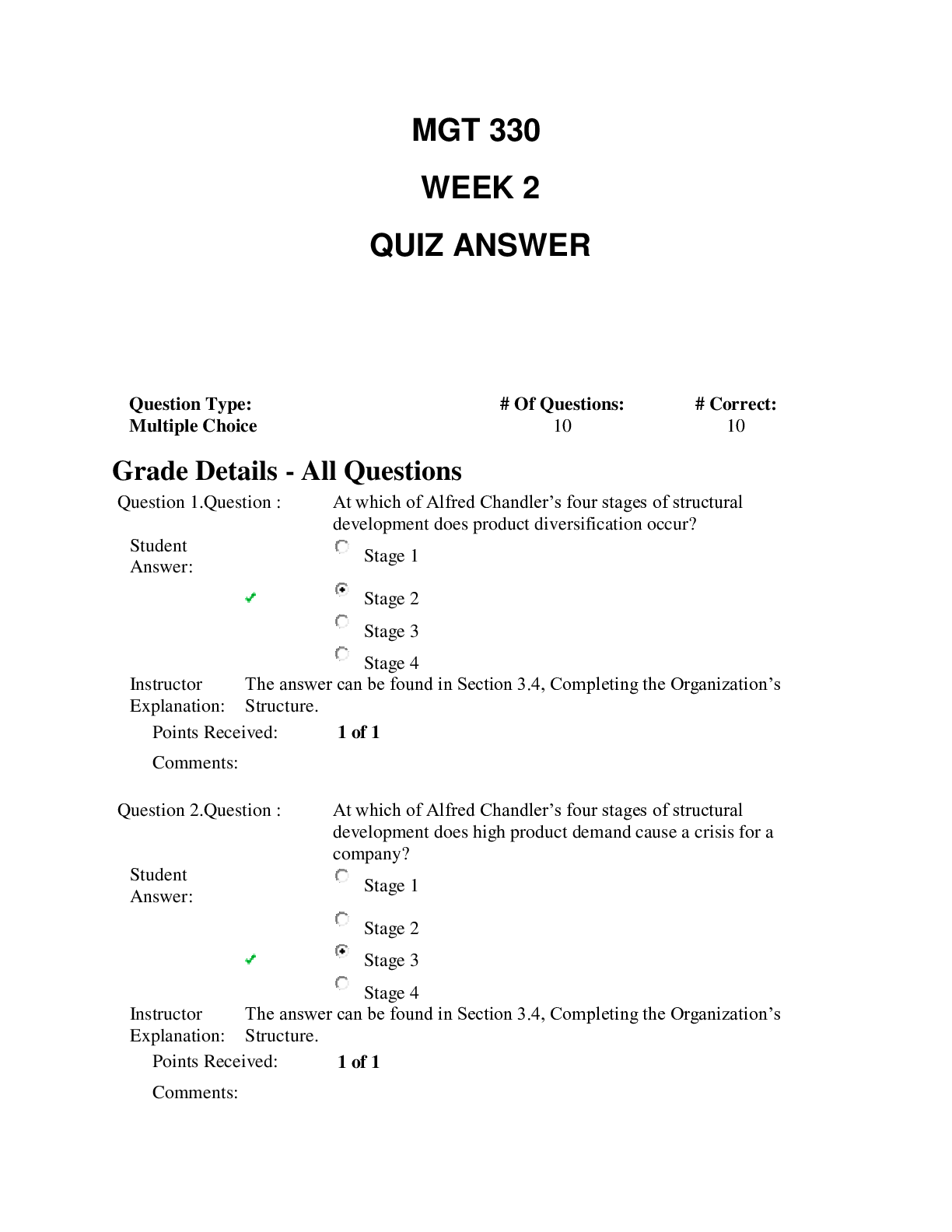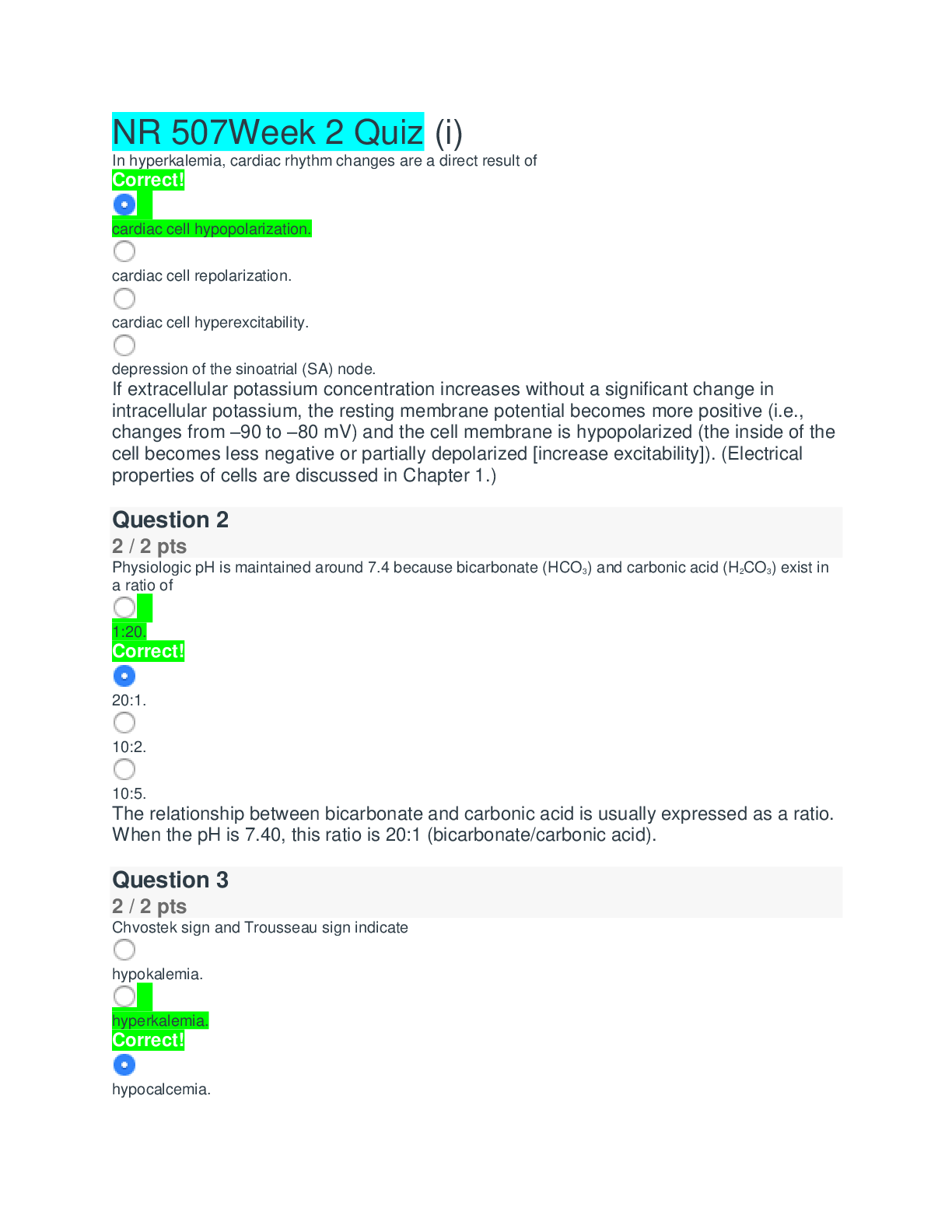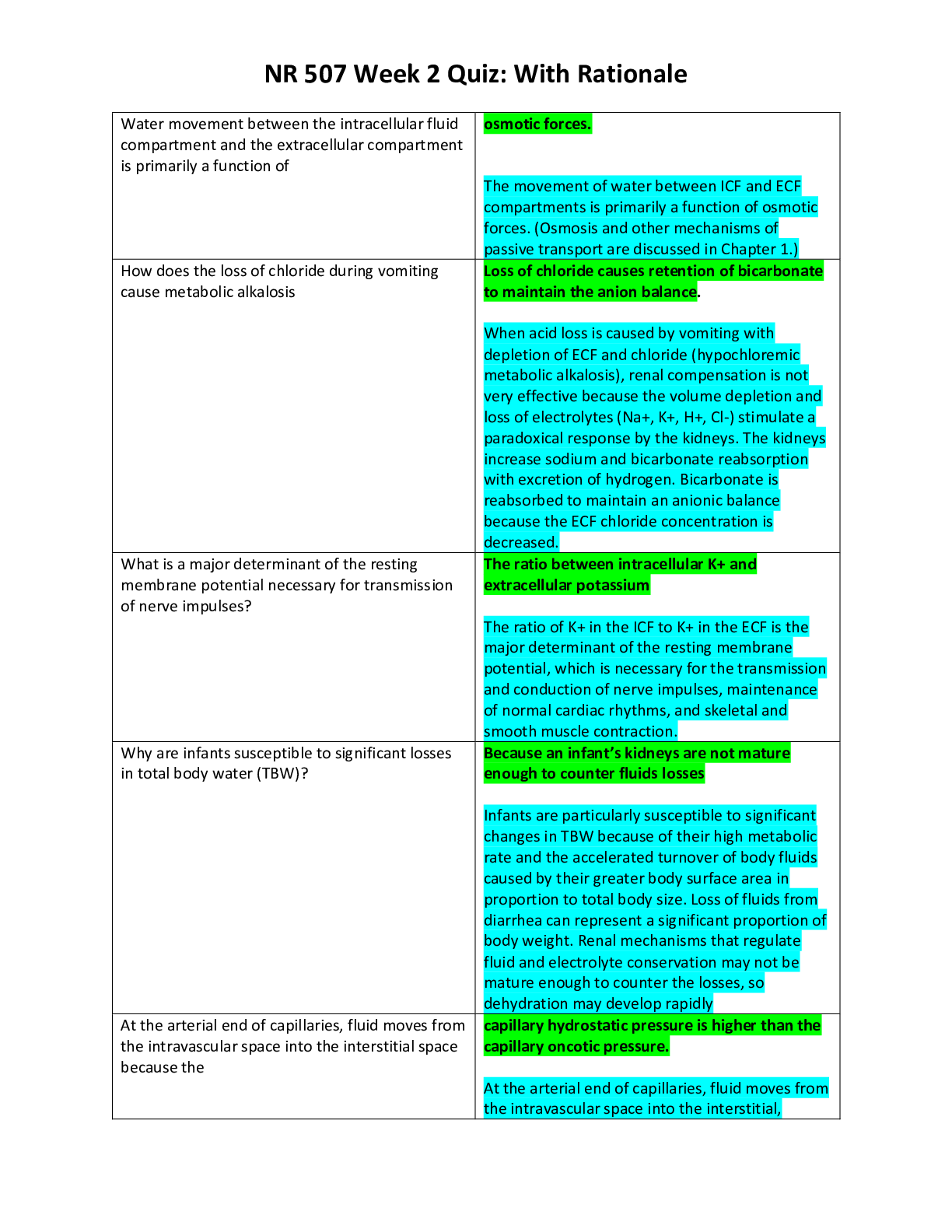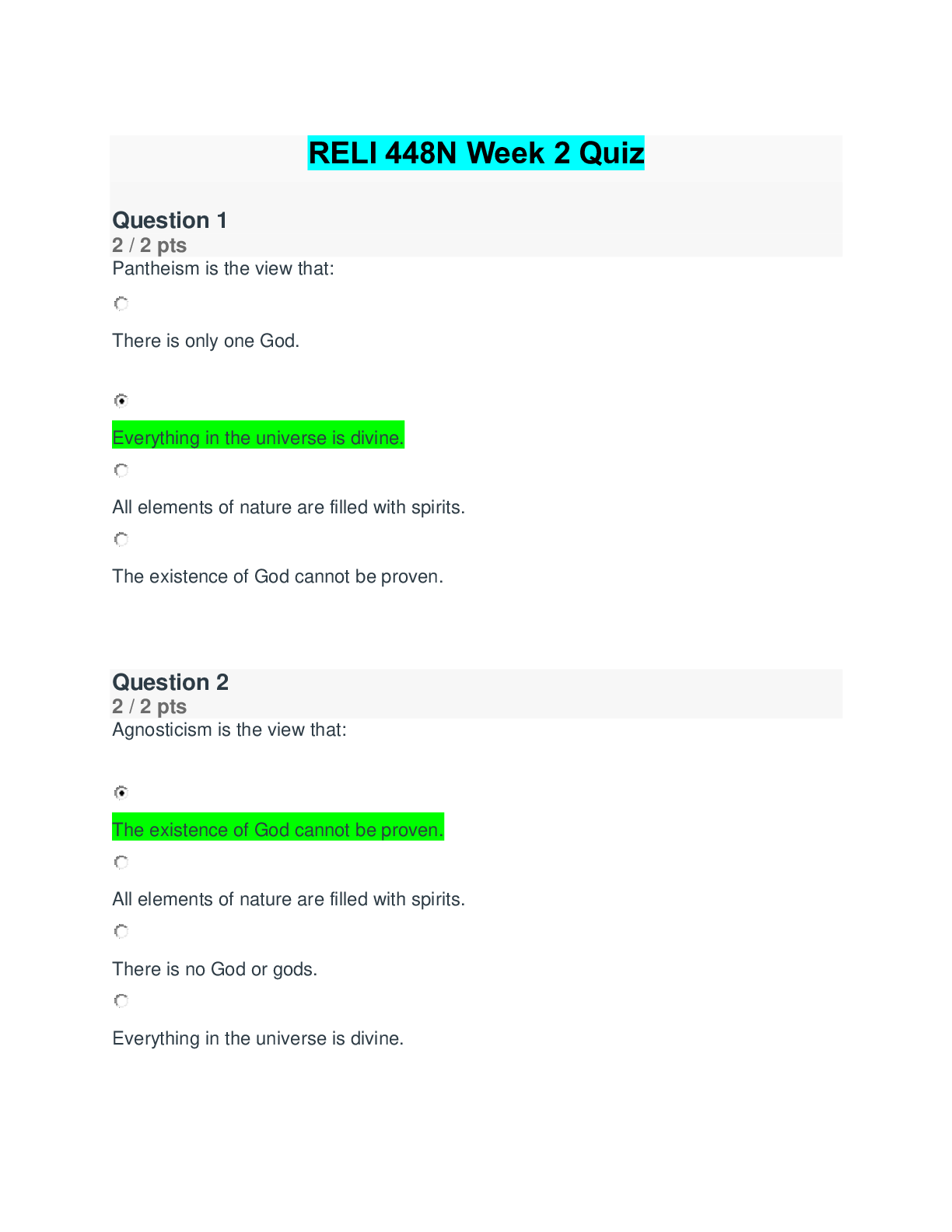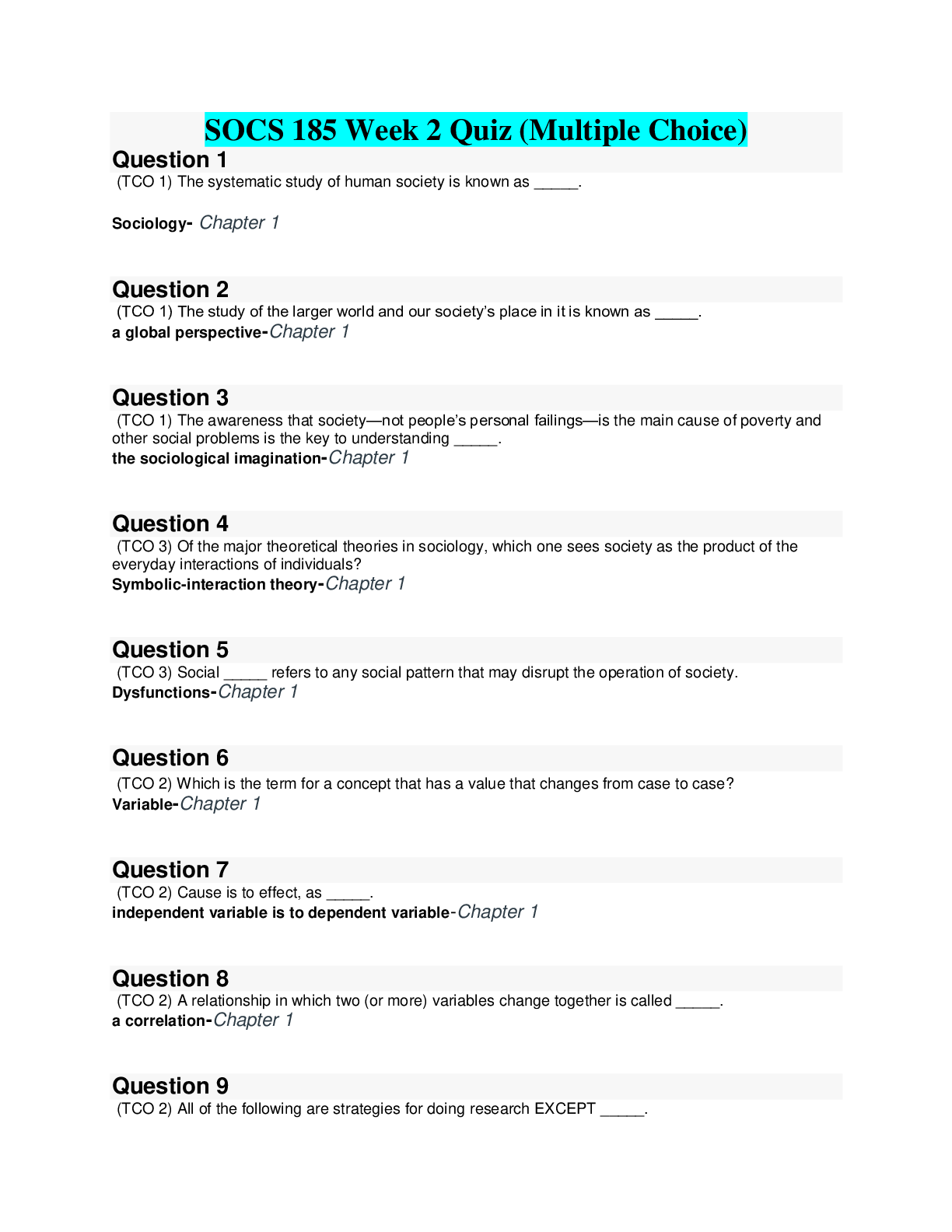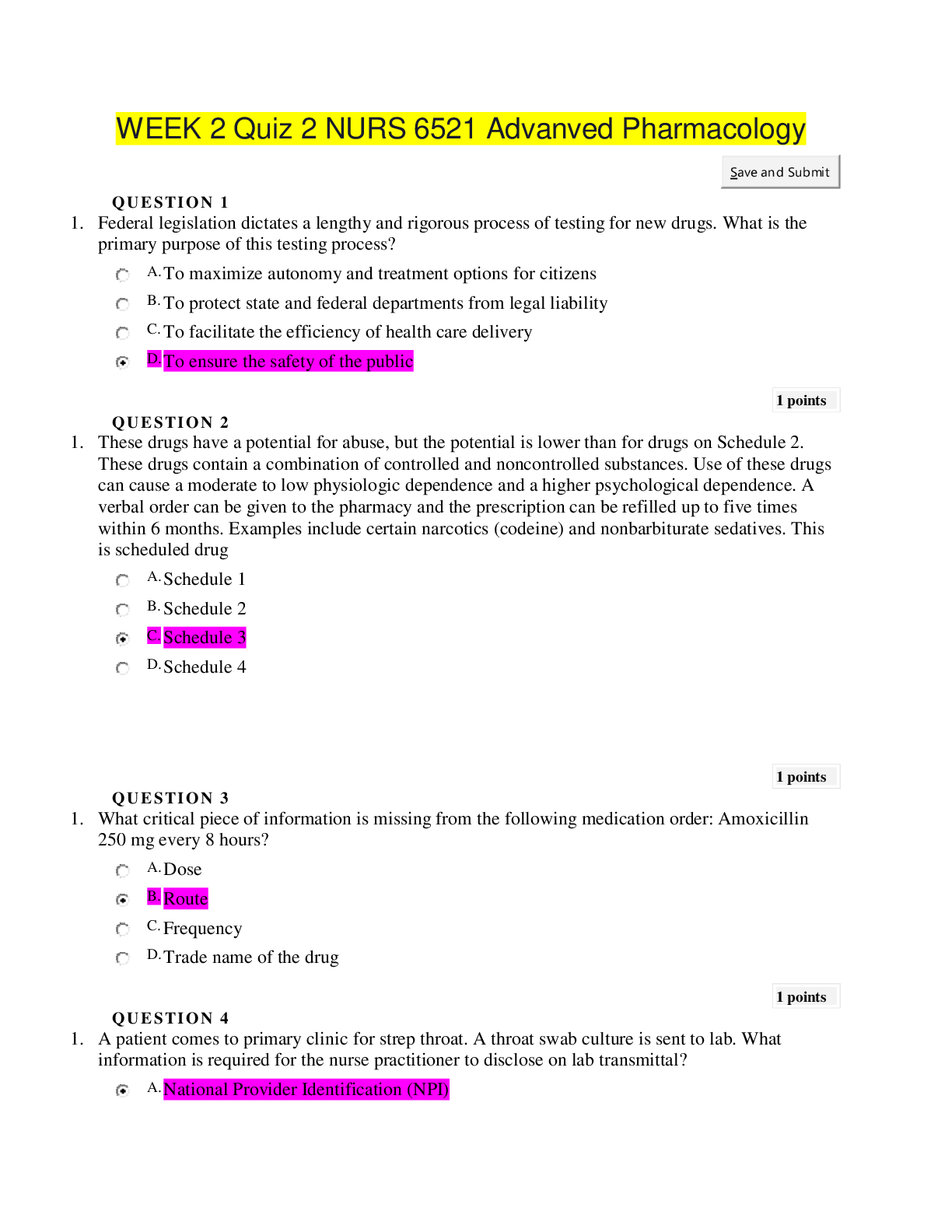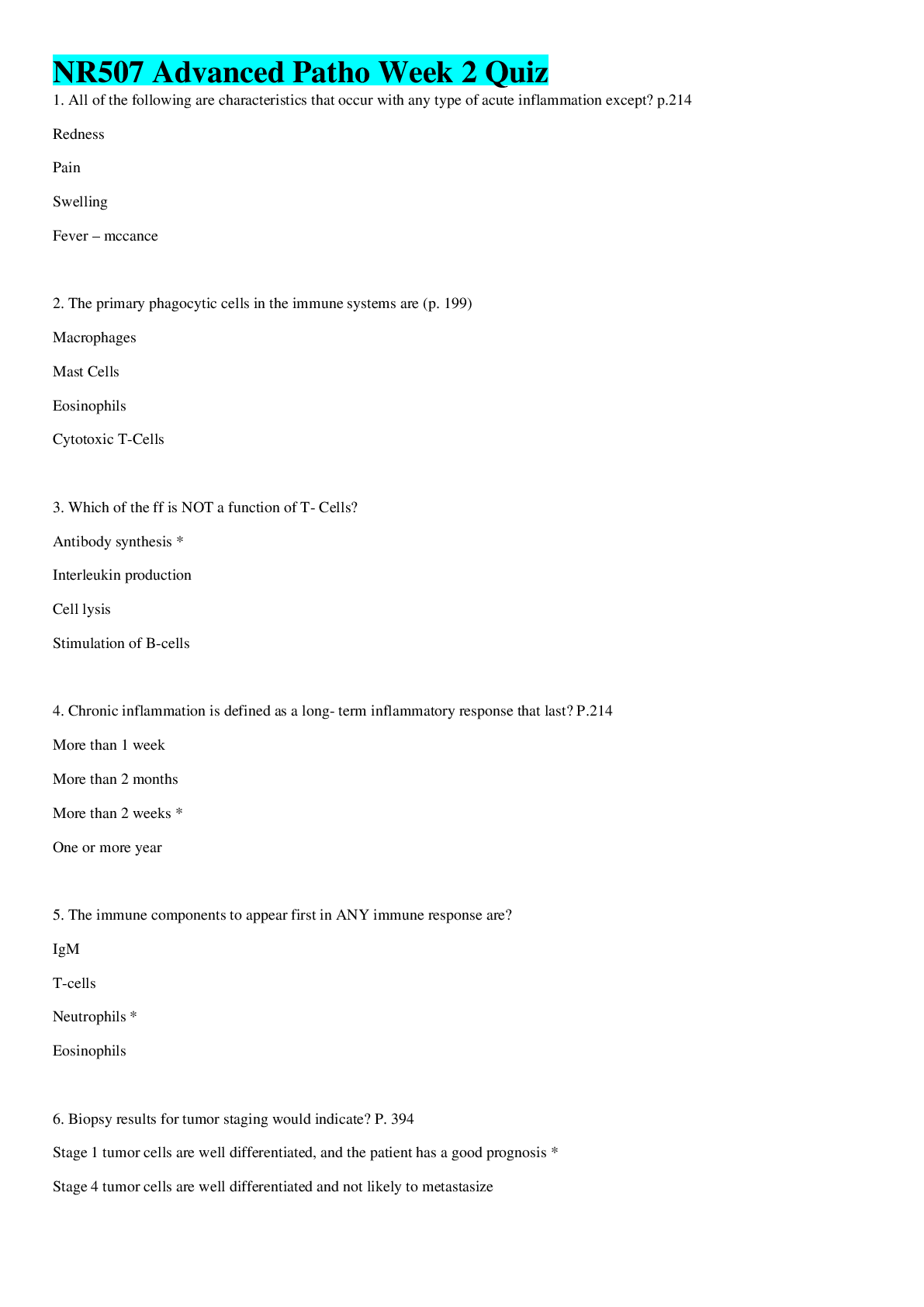Anatomy > EXAM > SCIN 132 Week 2 Quiz (GRADED A) Questions and Answers elaborations | Download To Score An A | Americ (All)
SCIN 132 Week 2 Quiz (GRADED A) Questions and Answers elaborations | Download To Score An A | American Militrary University
Document Content and Description Below
Week 2 Quiz Return to Assessment List Part 1 of 9 - 9.0/ 12.0 Points Question 1 of 32 0.0/ 3.0 Points Almost all of the liver of a human being is located in which abdominopelvic qua... drant? • A. Left upper quadrant (LUQ) • B. Left lower quadrant (LLQ) • C. Right upper quadrant (RUQ) • D. Epigastric quadrant • E. Right lower quadrant (RLQ) Feedback: The human liver is primarily located in the RUQ. Question 2 of 32 3.0/ 3.0 Points The ability of an organism to adjust to changes in either its internal or external environments is called . • A. development • B. responsiveness • C. movement • D. growth • E. homeostasis Feedback: Good work; your answer is correct! Question 3 of 32 3.0/ 3.0 Points Humans have the most urgent need for a continuous supply of . • A. oxygen • B. nitrogen • C. food • D. a controlled temperature • E. water Feedback: Good work; your answer is correct! Question 4 of 32 3.0/ 3.0 Points If some condition of the body needs to be returned to its “set point”, i.e. homeostasis, then a(n) feedback loop comes into play. • A. continuous • B. positive • C. reversed • D. outside • E. negative Feedback: Good work; your answer is correct! Part 2 of 9 - 12.0/ 15.0 Points Question 5 of 32 3.0/ 3.0 Points The molecules which store the genetic instructions of an organism is . • A. DNA • B. ADP • C. RNA • D. ATP • E. Histone Feedback: Good work; your answer is correct! Question 6 of 32 3.0/ 3.0 Points A molecule (or region of a molecule) that is attracted to water is known as a(n) molecule. • A. Hydrophobic • B. Bipolar • C. Bi-layerd • D. Hydrophilic • E. Integral Feedback: Good work; your answer is correct! Question 7 of 32 3.0/ 3.0 Points Which of the following sequences on a DNA molecule would be complementary to GCTTATAT? • A. TAGGCGCG • B. ATCCGCGC • C. CGAATATA • D. TGCCTCTC • E. None of the above Feedback: Good work; your answer is correct! Question 8 of 32 0.0/ 3.0 Points What is the name of the process during which a chain of amino acids called a polypeptide is synthesized? • A. Transcription • B. Splicing • C. Synthesizing • D. Trans-section • E. Translation Feedback: Like translating a book from one language into another, the codons on a strand of mRNA must be translated into the amino acid alphabet of proteins. Translation is the process of synthesizing a chain of amino acids called a polypeptide. Question 9 of 32 3.0/ 3.0 Points DNA, and the genes found on the strands of DNA, contain information necessary for synthesizing which type of material? • A. DNA • B. ATP • C. glucose • D. proteins • E. carbohydrates Feedback: Good work; your answer is correct! Part 3 of 9 - 9.0/ 12.0 Points Question 10 of 32 3.0/ 3.0 Points The standard and initial response of the body to injury is called . • A. necrosis • B. cell atrophy • C. fever • D. apoptosis • E. inflammation Feedback: Good work; your answer is correct! Question 11 of 32 0.0/ 3.0 Points The different types of cells are not randomly distributed throughout the body; rather they occur in organized layers, a level of organization referred to as . • A. epithelial • B. an organ • C. a cell system • D. tissue • E. an organ system Feedback: The above statement is a definition of tissue. Question 12 of 32 3.0/ 3.0 Points Cells of the body are organized into broad categories of tissue. • A. five • B. two • C. three • D. four • E. six Feedback: Good work; your answer is correct! Question 13 of 32 3.0/ 3.0 Points The broad categories of connective tissue include which of the following types of connective tissue? • A. connective tissue proper • B. supportive connect tissue • C. fluid connective tissue • D. bony connective tissue • E. A, B, and C are all correct Feedback: Good work; your answer is correct! Part 4 of 9 - 12.0/ 12.0 Points Question 14 of 32 3.0/ 3.0 Points What is the largest organ of the body? • A. Uterus • B. Liver • C. Heart • D. Skin • E. Brain Feedback: Good work; your answer is correct! Question 15 of 32 3.0/ 3.0 Points Because the skin sloughs off on a regular basis, the most superficial layer of the epidermis is primarily composed of what type of tissue? • A. Pseudostratified epithelium • B. Stratified squamous epithelium • C. Simple Columnar epithelium • D. Simple squamous epithelium • E. Cuboidal epithelium Feedback: Good work; your answer is correct! Question 16 of 32 3.0/ 3.0 Points Regarding the ABCDE mnemonic of a skin evaluation, “E” stands for . • A. Evolving • B. Ever-changing • C. Enormous • D. Eczema • E. None of the above Feedback: Good work; your answer is correct! Question 17 of 32 3.0/ 3.0 Points Which of the following cells are primarily responsible for producing the pigment that gives color to the skin? • A. Langerhans cells • B. Keratinocytes • C. Merkel cells • D. Basal cells • E. Melanocytes Feedback: Good work; your answer is correct! Part 5 of 9 - 3.0/ 6.0 Points Question 18 of 32 0.0/ 3.0 Points Which of the following substances require integral proteins to pass through the plasma membrane? • A. lipid-soluble substances • B. potassium • C. urea • D. water Feedback: Some substances like water are able to pass through the plasma membrane via simple diffusion whereas others require integral proteins to assist with the transport in a process called facilitated diffusion. Question 19 of 32 3.0/ 3.0 Points The sodium-potassium pump is an example of which of the following? • A. osmosis • B. active transport • C. simple diffusion • D. facilitated diffusion Feedback: Correct. Good job! Part 6 of 9 - 9.0/ 9.0 Points Question 20 of 32 3.0/ 3.0 Points What should be included when generating scientific questions? • A. Moral values • B. The word “why” • C. Predictions about outcomes • D. Personal preferences • E. Very broad topics Feedback: Correct! Scientific questions should be specific enough to help design a good hypothesis and should be based on facts, testable, and verifiable. Question 21 of 32 3.0/ 3.0 Points Which scientist helped develop the cell theory? • A. Charles Darwin • B. Robert Hooke • C. Gregor Mendel • D. Christopher Wren • E. Robert FitzRoy Feedback: Correct! This scientist began his journey to developing the cell theory by studying insects. Question 22 of 32 3.0/ 3.0 Points Which is NOT considered a component of scientific observations? • A. Generation of data • B. Personal beliefs • C. Limitations • D. Specialized tools • E. Measurability Feedback: Correct! In science, observations lead to the formation of hypotheses and must adhere to specific guidelines to be scientifically credible. Part 7 of 9 - 15.0/ 21.0 Points Question 23 of 32 0.0/ 3.0 Points Respiratory alkalosis is a result of . • A. too much carbon dioxide in the blood • B. too much oxygen in the blood • C. too little carbon dioxide in the blood • D. too little oxygen in the blood Feedback: Learning Objective: Define respiratory alkalosis and list examples of possible causes. Please review Lab Exercise 10, Activity 1. Question 24 of 32 0.0/ 3.0 Points Hyperventilation can result in . • A. too much oxygen in the blood • B. too much carbon dioxide in the blood • C. too little carbon dioxide in the blood • D. respiratory acidosis Feedback: Learning Objective: Describe the effects of hyperventilation and hypoventilation on blood PCO2 and pH. Please review Lab Exercise 10, Activity 1. Question 25 of 32 3.0/ 3.0 Points Which of the following is a substance that dissolves in water to release hydrogen ions? • A. protein buffer • B. acid • C. base • D. pH Feedback: Correct! Question 26 of 32 3.0/ 3.0 Points What is the normal range for pH in the blood? • A. 7.35-7.45 • B. 7.25-7.35 • C. 7.00-7.50 • D. 6.80-7.00 Feedback: Correct! Question 27 of 32 3.0/ 3.0 Points Which of the following is true about "rebreathing"? • A. PCO2 will typically decrease. • B. it will cause the body to go into a state of alkalosis. • C. Anxiety is respiratory problem that can mimic the effects of rebreathing. • D. pH typically will decrease. Feedback: Correct! Question 28 of 32 3.0/ 3.0 Points Hyperventilation is defined as . • A. an increase in the rate of breathing • B. an increase in the rate and depth of breathing • C. an increase in the depth of breathing • D. a decrease in the depth of breathing Feedback: Correct! Question 29 of 32 3.0/ 3.0 Points Which of the following is NOT a regulatory mechanism for acid/base balance in the body? • A. protein buffers • B. the digestive system • C. the kidneys • D. the respiratory system Feedback: Correct! Part 8 of 9 - 8.0/ 8.0 Points Answer the following question in your own words without using any resources. Your answer should be written in complete sentences using correct grammar, spelling, and terminology. Question 30 of 32 4.0/ 4.0 Points Define the term "buffer." a solution that can avoid change from other acid based chemicals or neutralize them Feedback: Learning Objective: Define the following terms; pH, acid, base, strong acid, weak acid, strong base, weak base, and buffer. Please review Lab Exercise 10, Overview. Comment: Correct! Question 31 of 32 4.0/ 4.0 Points Briefly explain how the renal system regulates acid-base balance. an acid base balancing rental system will regulate the acid base balance by absorbing or excreting the base and acids. Feedback: Learning Objective: Describe the chemical, renal system, and respiratory system buffer systems and place them in order from fastest to slowest. Please review Lab Exercise 10, Activity 2. Comment: Correct! Part 9 of 9 - 5.0/ 5.0 Points Instructions: 1. Click on the Browse button to find the lab report on your computer. 2. Click on the Upload button to attach your lab report to the quiz. Question 32 of 32 5.0/ 5.0 Points [Show More]
Last updated: 2 years ago
Preview 1 out of 26 pages

Buy this document to get the full access instantly
Instant Download Access after purchase
Buy NowInstant download
We Accept:

Reviews( 0 )
$16.00
Can't find what you want? Try our AI powered Search
Document information
Connected school, study & course
About the document
Uploaded On
Apr 05, 2022
Number of pages
26
Written in
Additional information
This document has been written for:
Uploaded
Apr 05, 2022
Downloads
0
Views
47



 Questions and Answers 100% VERIFIED.png)
 Questions and Answers 100% correct Solutions.png)






.png)

